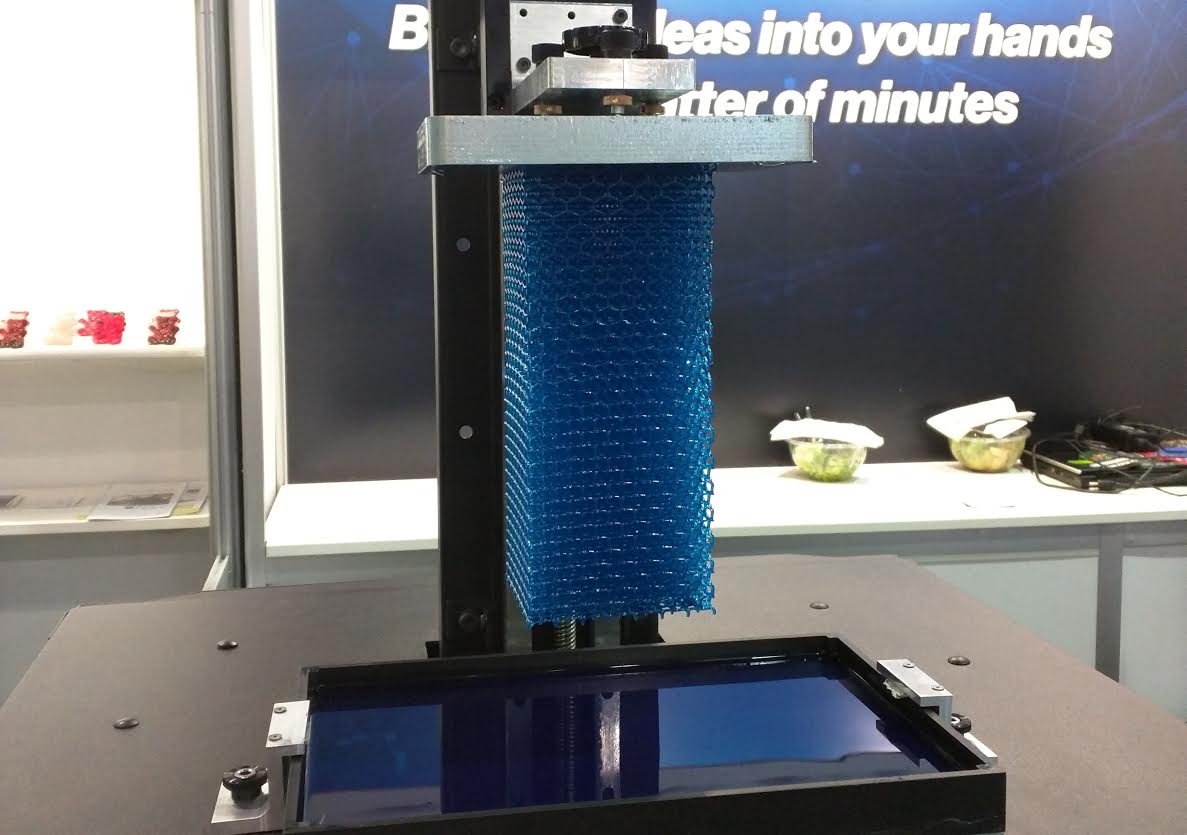 Have I mentioned how much I love going to the Consumer Electronics Show? Not only do I get to geek out on all the amazing gadgets, but I get an opportunity to see some of the latest advancements in 3D printing technology.
Have I mentioned how much I love going to the Consumer Electronics Show? Not only do I get to geek out on all the amazing gadgets, but I get an opportunity to see some of the latest advancements in 3D printing technology.
This year though, I think it was more about what you didn’t see, than what you did.
The Old Guard
It’s been a crazy year for 3D printing. A year ago 3D Systems (DDD) stock was selling for $30 per share. The other day it closed under $7. In early 2015, Stratasys (SSYS) stock was on the rise, heading for $80. Earlier this week it was under $17.
That’s a hell of a lot of lost market cap for such a small industry.
It showed at CES. Recently, both Stratasys and 3D Systems made decisions to pull the plug on consumer 3D printing. MakerBots weren’t exactly flying off the shelves, so earlier in the year (and again later) Stratasys laid-off a sizable percentage of that group’s workforce. Simultaneously, quality and customer service issues began to rack up. MakerBot announced a pivot, away from consumer sales and towards the education and professional markets.
The situation at 3D Systems was even more fluid. Just weeks before CES, 3D Systems announced that it would stop selling its Cube line of consumer 3D printers, shutter Cubify, its online consumer marketplace, and stop selling 3D printed products direct to consumers.
But CES is a serious investment and the decision to exhibit must have been made long before. So both companies showed up, and wow, was it different. A total 180 from the years before.
Instead of MakerBot and Cube, both companies were showing off their industrial printers. At the 3D Systems booth, you could walk up and see the ProX DMP 320 and ProX 500 in action. Stratasys had a Connex3 on the floor, but they seemed more interested in displaying a motorcycle that didn’t appear to be 3D printed.
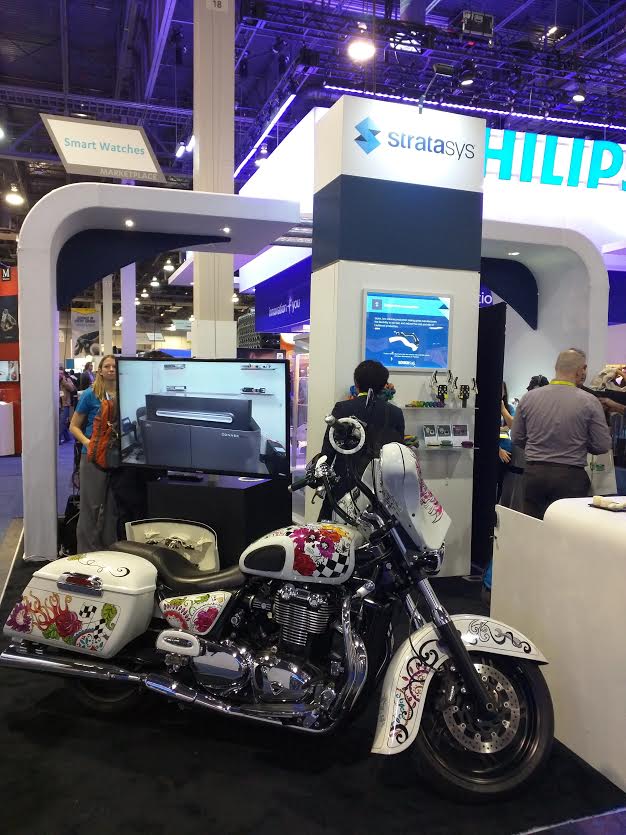 But, what really confused me was the messaging. 3D Systems’ goal was to “transform manufacturing” and “redefine the assembly line.”
But, what really confused me was the messaging. 3D Systems’ goal was to “transform manufacturing” and “redefine the assembly line.”
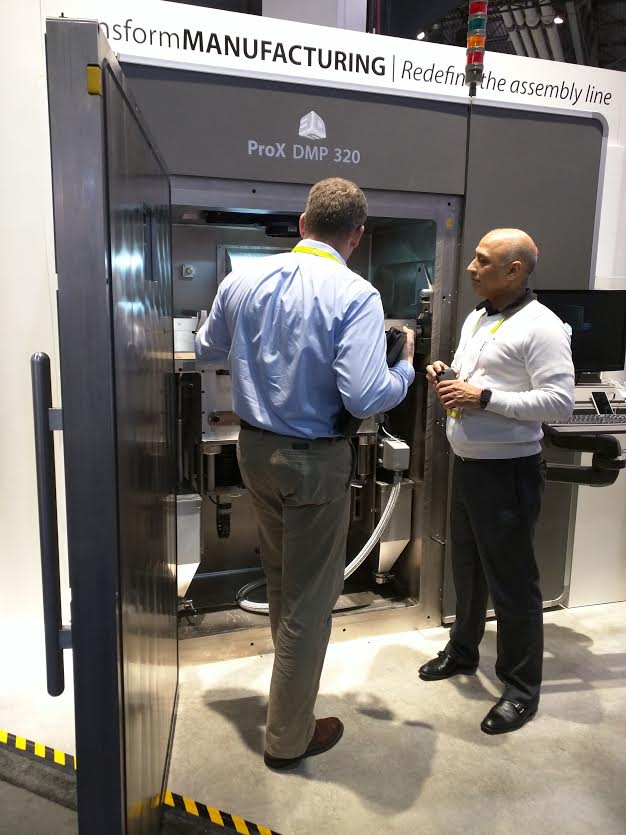 That seems like something that would be more interesting to a plant manager than it would be to the retailers, brands, and others representing the consumer products industry.
That seems like something that would be more interesting to a plant manager than it would be to the retailers, brands, and others representing the consumer products industry.
Stratasys was really out there, positioning itself as “the new shape of manufacturing,” and as proof, advertising its relationship with Joe Gibbs racing.
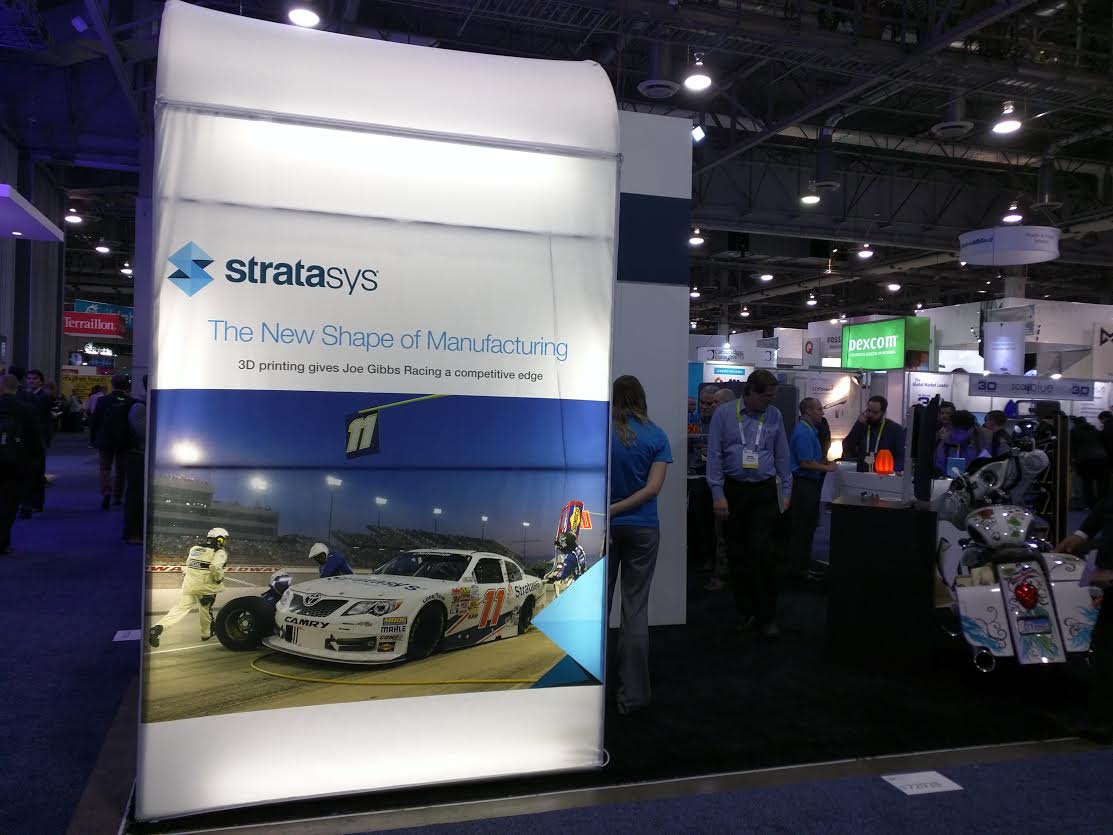 It was almost as though, through a freak accident, someone at both companies sent the wrong exhibit to the wrong place at the same time. The booths they sent were way more suited to an audience of engineers than the tech crowd attending CES.
It was almost as though, through a freak accident, someone at both companies sent the wrong exhibit to the wrong place at the same time. The booths they sent were way more suited to an audience of engineers than the tech crowd attending CES.
It will be very interesting to see what they bring to RAPID, in just a few weeks from now.
The New Guard
A lot of big companies have announced plans to enter the 3D printing market over the last two years. HP, Ricoh, Mutoh and Toshiba, for example, all plan to manufacture 3D printing equipment. Konica-Minolta and Canon are reselling 3D Systems gear. Others have announced big investments in the space. Google’s $100 million bet on Carbon3D comes first to mind, but others like Michelin and Alcoa have also made plays.
While representatives from some of these “new guard” companies spoke at CES, none of them had a real presence in the 3D printing area. I get that no one wants to sell vaporware, and as I mentioned above, selling industrial equipment at a consumer product trade show is a bit of a leap, but…
“People don’t want to buy a quarter-inch drill. They want a quarter-inch hole!”
That famous quote comes from Harvard Business School Professor Theodore Levitt (which he attributed to Leo McGinneva). The point he was making had to do with cause and effect. Consumers have a need and want to fill it. Marketing should focus on how their products do that, not speeds and feeds.
Another is Charles Revson’s famous distinction regarding the business of Revlon: “In the factory we make cosmetics. In the store we sell hope.”
It would have been nice to see both the old and new guard selling a bit more hope (not hype).
Where better to show real-world examples of the kind of impact their new 3D printing technology could have on the overall consumer products industry?
It’s a Tactile Business
Each year Gibson Guitar gives away hats at CES. I wear those hats a lot…and Gibson gets a lot of cheap advertising. That’s why they do it and that’s why the promotional products industry is a $22 billion business.
I spent four days walking the floor this year at CES. Promotional items were everywhere. I was offered everything from cheap ball points to high-end bluetooth headsets.
So why are so few 3D printed products given away at CES? Sure, the vendors have samples you can look at (and maybe touch) but rarely do you walk away with anything in hand.
Need an example? Consider the coffee cup sleeves being promoted at the show by M3D.
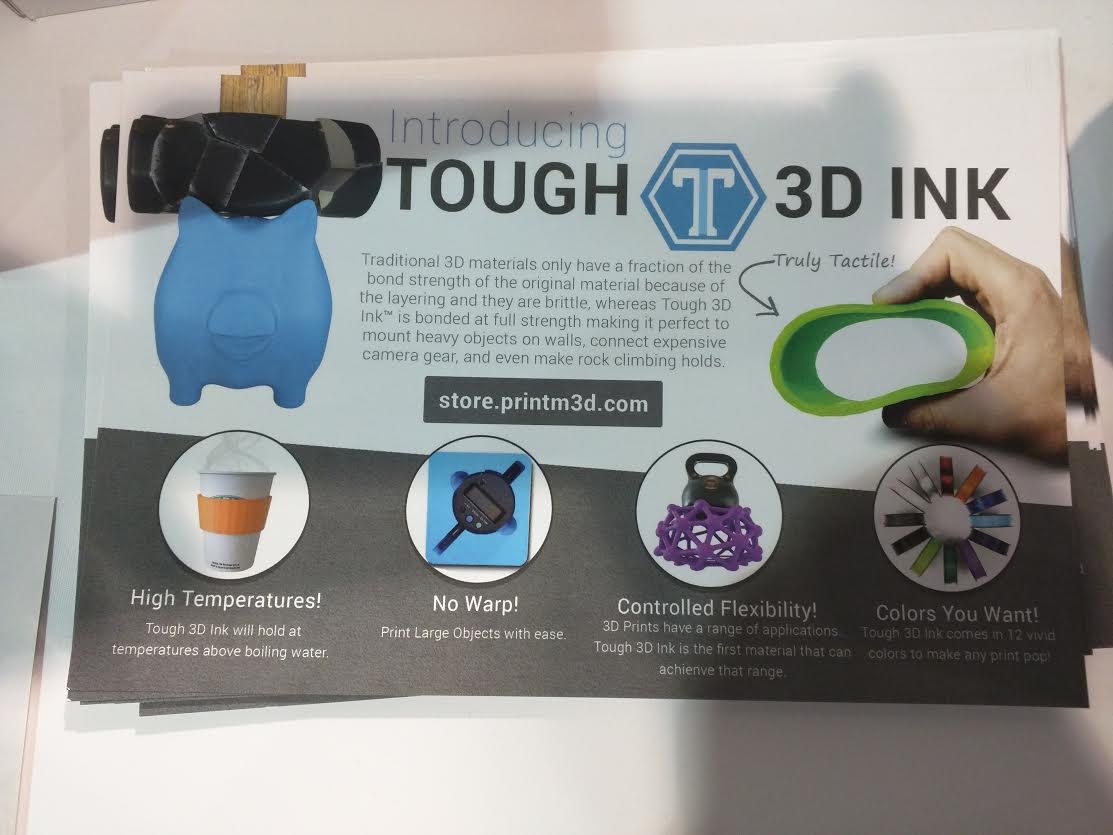 You know…instead of telling people it’s “truly tactile,” you could just hand them one?
You know…instead of telling people it’s “truly tactile,” you could just hand them one?
Those coffee sleeves should have been everywhere, right? They could have emblazoned them with the M3D logo, or potentially could have partnered with someone else for a killer case study.
I’m sure there’s a coffee company out there that would have loved the opportunity to have its brand on a cool 3D printed product at CES.
Another opportunity missed.
Licensing Works
As I mentioned in my last article, some people see licensing as a killer app. I see it as more of a “killer enabler.” But, a licensing relationship can also be a detriment if it somehow devalues the brand.
Consider Polaroid. They have a long pedigree in imaging and a great brand name, which consumers know and trust. It makes total sense for them to enter the 3D printing market, and licensing could be an effective way to accomplish that goal.
Here’s a public service announcement. I know it’s tempting when you see it on paper, but the closed model of razors and blades just doesn’t work in this market. A Facebook post from a well-known influencer after the unveiling of Polaroid’s new printer, summed it up:
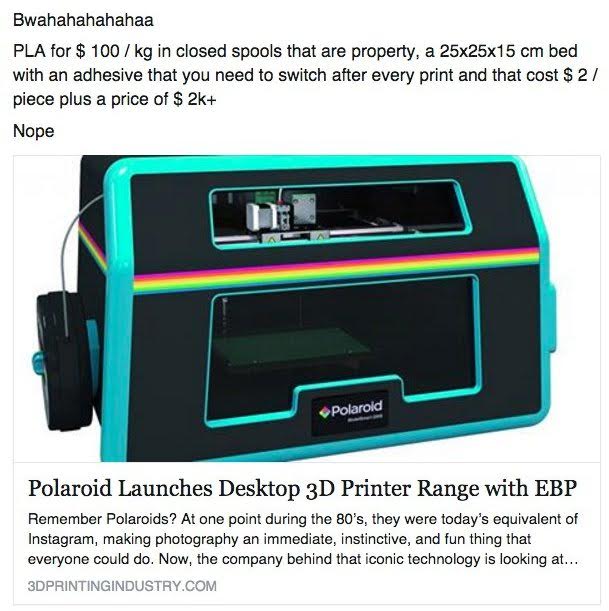 The product offering has to match the brand’s audience. Maybe a brand like Dremel resonates more with the prosumer and industrial users of 3D printers, but Polaroid’s strength is with everyday consumers.
The product offering has to match the brand’s audience. Maybe a brand like Dremel resonates more with the prosumer and industrial users of 3D printers, but Polaroid’s strength is with everyday consumers.
Another public service announcement. If you’re a consumer brand, and you really insist on licensing a desktop FDM printer, here’s a quick list of things to NOT do:
- Don’t make the consumables “proprietary”
- Don’t put a little printer in a big, mostly enclosed box
- Don’t get complicated with the mechanics (extruder, bed, etc.)
- Don’t let the price get over $1,000
FDM Isn’t The Answer
Fused deposition modeling (FDM) has a limited future with consumers. A lot of the people I talked with at CES (including some manufacturers of 3D printers themselves) see better options coming soon.
One big problem with FDM might be health related. When extruders melt ABS and other plastics, they release carcinogens and other toxins into the air. Most desktop 3D printers aren’t placed in well ventilated areas. Could this be a looming issue for an industry that expects to sell hundreds of thousands of desktop FDM printers in 2016 alone?
There are alternatives. 3D-FUEL was at CES, demonstrating an algae-based filament that is non-toxic and biodegradable, yet offers some of the same properties as plastic.
I do think FDM will remain relevant for longer in other areas like medicine, food and construction where they’re printing in unique materials like chocolate, concrete and living tissue.
Desktop SLA Evolves
Stereolithography (SLA) typically offers better print quality than FDM. There are several other pluses and minuses, and one of the biggest was cost. SLA machines were typically much more expensive. Lately, that’s changing. Take a look at this resin-based printer that can allegedly print 50 times faster than a FormLabs Form 2. It’s expected to sell for under $2,000.
New Technology
Newer technologies are on the horizon. They promise faster speed, bigger build areas, better quality, multi-materials, full-color, lower total cost of ownership and more. Even though most of the “New Guard” companies didn’t exhibit, there were signs that the industry’s technology is changing. Consider this offering from NewPro3D.
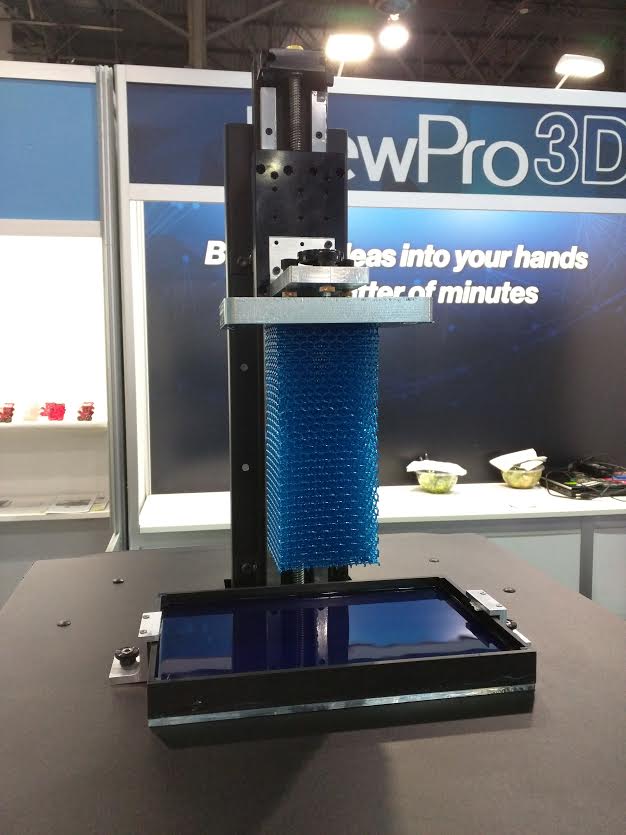 They’re calling it the world’s fastest 3D printer.
They’re calling it the world’s fastest 3D printer.
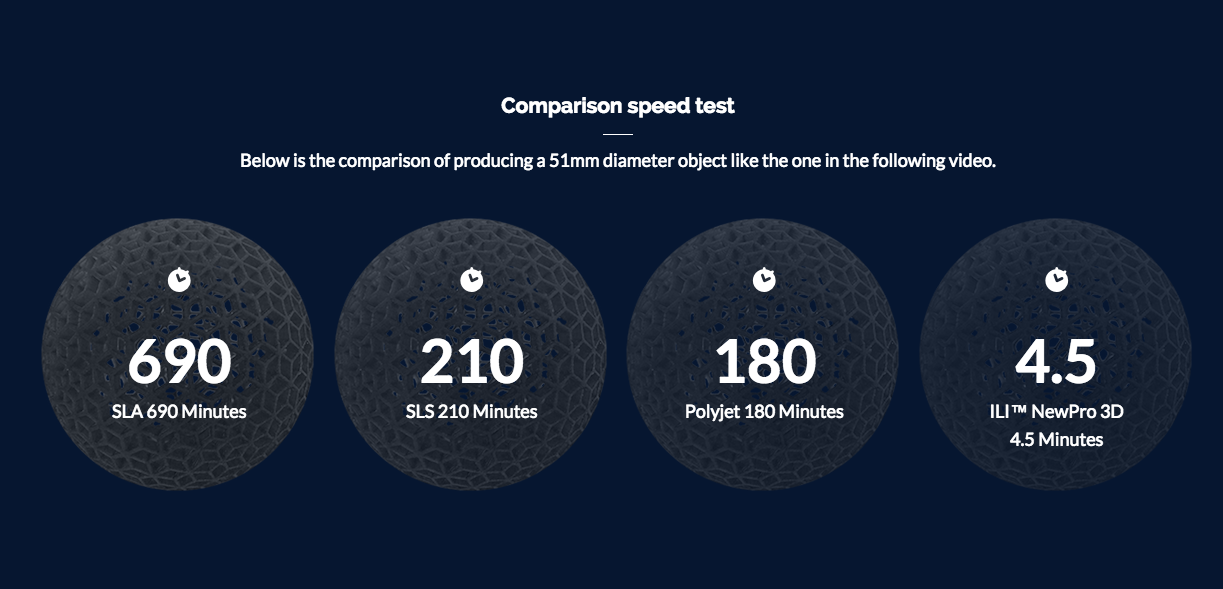 NewPro3D uses what it’s calling Intelligent Liquid Interface (ILI) to form the part as it emerges from a vat of material.
NewPro3D uses what it’s calling Intelligent Liquid Interface (ILI) to form the part as it emerges from a vat of material.
If that seems familiar, it’s probably because it looks a lot like the continuous liquid interface production (CLIP) technology used by Carbon3D.
Beyond 3D Printing
Digital technology is poised to change how, where, and when we make consumer products. 3D printing is a big part of it, but other technologies are also likely to play a role. CNC machines and laser cutters come immediately to mind.
I was impressed with the build sizes, material choices, and price of the SLA printers on display at Full Spectrum Laser’s booth. But in addition to 3D printers, as their name implies, they also make laser cutters. They are impressive machines in their own right and seeing them there was a great reminder that digital manufacturing is bigger than just 3D printing.
I Have a Dream
Here’s my dream for CES 2017. The 3D printing marketplace expands to over 100 companies. The old guard is back, but the new guard shows up too. HP, Carbon3D, Ricoh, Toshiba, and Canon all have booths. Beyond that there’s a greater focus on the process of 3D printing. Companies throughout the ecosystem are represented – from content to fulfillment. The floor is organized thoughtfully, with dedicated areas for equipment, consumables, software, and services. Hey, and maybe I even get invited to deliver a keynote. It is my dream after all!
In my next article I’ll write about all the great virtual and augmented reality technology that was on display at CES and I’ll make the case for why my last article (about 3D content) might be even more relevant to AR than 3D.
___________________________
John Hauer is the Founder and CEO of Get3DSmart, a consulting practice which helps large companies understand and capitalize on opportunities with 3D printing. Prior to that, John co-founded and served as the CEO of 3DLT. The company worked with retailers and their suppliers, helping them sell 3D printable products, online and in-store.
John’s original content has been featured on TechCrunch, QZ.com, Techfaster.com, 3DPrint.com and Inside3DP.com, among others. Follow him on Twitter at @maverickonline
Subscribe to Our Email Newsletter
Stay up-to-date on all the latest news from the 3D printing industry and receive information and offers from third party vendors.
You May Also Like
3D Printing Unpeeled: New Arkema Material for HP, Saddle and Macro MEMS
A new Arkema material for MJF is said to reduce costs per part by up to 25% and have an 85% reusability ratio. HP 3D HR PA 12 S has been...
3D Printing News Briefs, January 20, 2024: FDM, LPBF, Underwater 3D Printer, Racing, & More
We’re starting off with a process certification in today’s 3D Printing News Briefs, and then moving on to research about solute trapping, laser powder bed fusion, and then moving on...
3D Printing Webinar and Event Roundup: December 3, 2023
We’ve got plenty of events and webinars coming up for you this week! Quickparts is having a Manufacturing Roadshow, America Makes is holding a Member Town Hall, Stratafest makes two...
Formnext 2023 Day Three: Slam Dunk
I’m high—high on trade show. I’ve met numerous new faces and reconnected with old friends, creating an absolutely wonderful atmosphere. The excitement is palpable over several emerging developments. The high...































